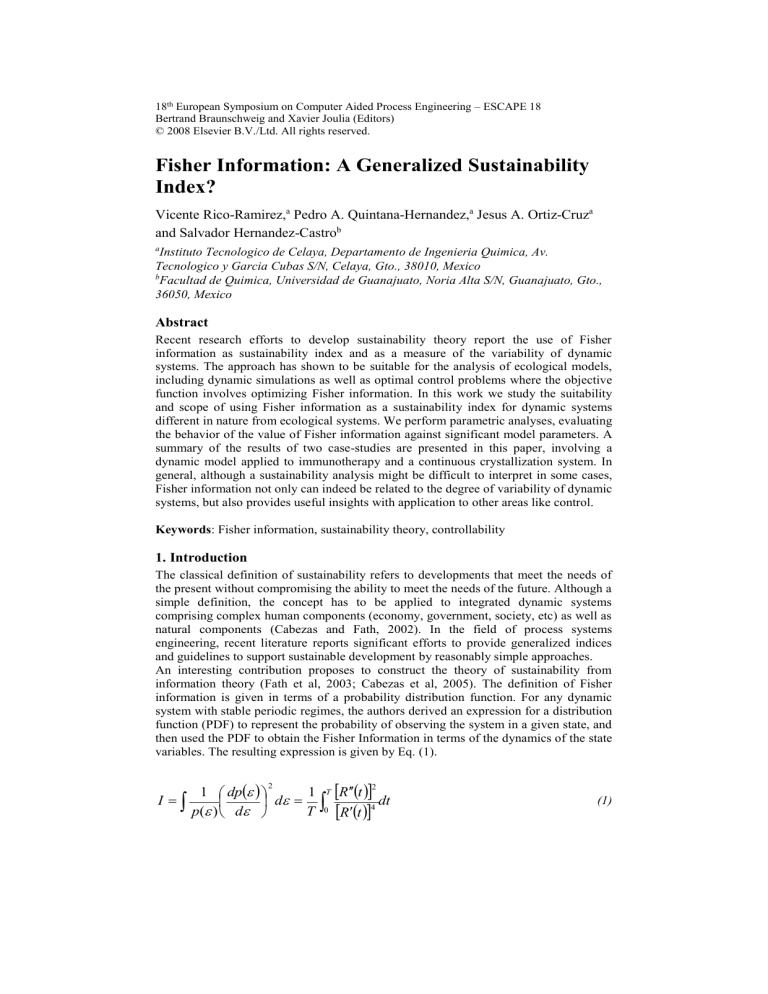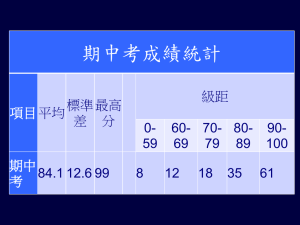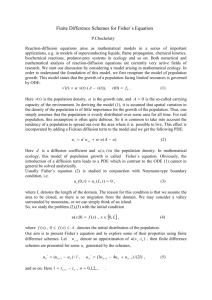Chapter

18 th European Symposium on Computer Aided Process Engineering – ESCAPE 18
Bertrand Braunschweig and Xavier Joulia (Editors)
© 2008 Elsevier B.V./Ltd. All rights reserved.
Fisher Information: A Generalized Sustainability
Index?
Vicente Rico-Ramirez,
a
Pedro A. Quintana-Hernandez,
a
Jesus A. Ortiz-Cruz
a
and Salvador Hernandez-Castro
b a Instituto Tecnologico de Celaya, Departamento de Ingenieria Quimica, Av.
Tecnologico y Garcia Cubas S/N, Celaya, Gto., 38010, Mexico b Facultad de Quimica, Universidad de Guanajuato, Noria Alta S/N, Guanajuato, Gto.,
36050, Mexico
Abstract
Recent research efforts to develop sustainability theory report the use of Fisher information as sustainability index and as a measure of the variability of dynamic systems. The approach has shown to be suitable for the analysis of ecological models, including dynamic simulations as well as optimal control problems where the objective function involves optimizing Fisher information. In this work we study the suitability and scope of using Fisher information as a sustainability index for dynamic systems different in nature from ecological systems. We perform parametric analyses, evaluating the behavior of the value of Fisher information against significant model parameters. A summary of the results of two case-studies are presented in this paper, involving a dynamic model applied to immunotherapy and a continuous crystallization system. In general, although a sustainability analysis might be difficult to interpret in some cases,
Fisher information not only can indeed be related to the degree of variability of dynamic systems, but also provides useful insights with application to other areas like control.
Keywords : Fisher information, sustainability theory, controllability
1.
Introduction
The classical definition of sustainability refers to developments that meet the needs of the present without compromising the ability to meet the needs of the future. Although a simple definition, the concept has to be applied to integrated dynamic systems comprising complex human components (economy, government, society, etc) as well as natural components (Cabezas and Fath, 2002). In the field of process systems engineering, recent literature reports significant efforts to provide generalized indices and guidelines to support sustainable development by reasonably simple approaches.
An interesting contribution proposes to construct the theory of sustainability from information theory (Fath et al, 2003; Cabezas et al, 2005). The definition of Fisher information is given in terms of a probability distribution function. For any dynamic system with stable periodic regimes, the authors derived an expression for a distribution function (PDF) to represent the probability of observing the system in a given state, and then used the PDF to obtain the Fisher Information in terms of the dynamics of the state variables. The resulting expression is given by Eq. (1).
I
1 p (
) dp
d
2 d
1
T
T
0
R
R
t
2
4 dt (1)
2 V. Rico-Ramirez et al.
In Eq. (1), R
and R
are defined by Eq. (2) and Eq. (3).
R
n i
1
dy i dt
2
(2)
R
R
1
n i
1 dy i dt d
2 y i dt
2
(3)
It has been shown that Fisher information is a function of the variability of the observations (Pawlowski et al., 2005). A uniform PDF means that the probability of the variable taking any particular value is no greater than that of any other value, which results in a system with zero Fisher Information. A more structured system shows bias to a particular set of states and the PDF is more steeply sloped about these values, in which case Fisher information increases with the sharpness of the PDF (See Fig. 1).
Therefore, Fisher information has the potential to indicate changes in system organization as reflected in the dynamic behavior of the system state. The theory developed was proven to be suitable for ecological models in stable periodic regimes, where the time period is known. The idea was also extended to dynamic optimization applications where the objective function involved maximizing or minimizing Fisher information as the sustainability index (Shastri and Diwekar, 2006). A question then arises, can Fisher Information be used as the basis for generalized sustainability theory in dynamic systems different from ecological models?. This work studies the suitability and scope of using Fisher information as a sustainability index for non ecological dynamic models in diverse disciplines; in particular, this paper shows our findings in two case-studies.
2.
Case-Studies
From Eq. 1 through Eq. 3, it should be noticed that Fisher information can be computed for basically any continuous dynamic model where the time period T is known. Besides, in all of the cases we have studied, we consider conditions where the assumption of having stable periodic regimes remains as valid.
Probability
Distribution
Function
High Fisher
Information
Zero Fisher
Information
Low Fisher
Information
Figure 1. Fisher information as a measure of the variability of a dynamic system
Fisher Information: A Generalized Sustainability Index?
2.1.
Therapeutic Optimization: Immunotherapy for cancer treatment
The first case-study corresponds to a dynamic model of immunotherapy for cancer treatment (Burden et al, 2004). Immunotherapy refers to the use of natural and synthetic substances to stimulate the immune response. Immunological therapies include the use of agents such as cytokines. Cytokines are hormones produced in the immune system that regulate the growth and activity of other immune system cells and blood cells. The model given in Eq. (4) represents the dynamics between tumor cells ( y ), immune or effector cells ( x ), and cytokine interleukin-2 (IL-2, z ). Fig. 2 shows the open loop ( u=0 ) dynamics of the state variables. The model parameters were taken from Burden et al
(2004). The control u(t) represents an external source of e ff ector cells. u(t)=1 represents maximum immunotherapy, u(t)=0 means no immunotherapy. dx dt
dy dt cy
dz dt
r
2
2 x
g p
1
1 xz
z y
1
by
g
2
u
s
1 axy
y
g p
2 xy
3 y
3 z
(4)
2.2.
Crystallization
The second case-study corresponds to the continuous isothermal crystallization of ammonium sulphate. Since the shape of the crystal size distribution has a significant impact on the properties of the product, crystallization requires a population balance in order to be accurately described. A dynamic model for the crystallizer can be derived from the population balance by using the method of moments (Chiu and Christofides,
1998). The resulting system of differential equations is given by Eq. (5).
2.5
x 10
5 immune system cells cancer cells
IL-2 cells
2
3
1.5
1
0.5
0
0 50 100 150 200
Time [=] days
250 300
Figure 2. Open loop state dynamics in the immunotherapy model
350 400
4 V. Rico-Ramirez et al.
dC
C
0 dt
C
4
k
1
C
C s
2
c
C
dm
0 dt
m
0
( 1
4
3
m
3
)
k
2
exp
k
3 dm
1 dt dm
2 dt dm
3 dt
m
1
m
2
m
3
k
1
C
C s
m
0
2
k
1
3
k
1
C
C
C s
C s
m
1
m
2
1
C
Cs
4
m
3
3
1
2
(5)
C is the ammonium sulphate concentration. A simulation by using the model parameters reported by Melendez-Gonzalez (2006) results in the crystal size dynamics shown in
Fig. 3. That work assumes values of C
0
=1.0 g/cm 3 and
= 1.0 h.
3.
Results
We performed parametric analyses, evaluating the behavior of the value of Fisher information against significant model parameters. The results of both case-studies are summarized here.
3.1.
Immunotherapy
This example, although different in principle from an ecological model, can be interpreted as a system where a group of cells (“species”) co-exist and “struggle for survival” and, therefore, its analysis is similar to those of ecological models. Hence, the sustainability theory reported in the literature can be applied. The objective should be to obtain a non-sustainable state though, since it is desirable to eliminate one of the
“species” (cancer cells). A parametric analysis was performed. Here we show just some results on the effect of the control variable in the value of Fisher information of the system.
2500
2000
1500
1000
500
0
0 20
Figure 3. Crystal size dynamics
40 60
Time [=] h
80 100
Fisher Information: A Generalized Sustainability Index?
Fig. 2 showed the open loop ( u=0 ) dynamics of the model. That case implies that no immunotherapy is applied and all the coexisting cells grow in periodic intervals (cancer cells are not eliminated). From the point of view of sustainability, that is the more sustainable regime. In fact, this is the case with higher Fisher information (0.0434). Fig.
4 shows the case where u=1 at all times (maximum immunotherapy); the value of
Fisher information is 1.2742x10
-6 . Notice that the amounts of cancer cells and IL-2 cells are small; this case would represent a non-sustainable case (Fisher information is low).
An intermediate value of Fisher information (not shown) comes from the optimal control policy, where cancer cells tend to disappear, but IL-2 and immune cells also remain in the system, although the dynamics is quite different from that of Fig. 4.
3.2.
Crystallization
In this case, the idea of a sustainable state might be unclear, but sustainability may be referred to the robustness of a preferred dynamic regime to natural disturbances. In this context, we study the behavior of Fisher information against the two main model parameters, C
0
(initial solute concentration) and
(residence time). A significant result is obtained in this analysis; the maximum value of Fisher information corresponds to
C
0
=0.9905g/cm 3 and
=1.1890 h. When a dynamic simulation is performed, the resulting profile is the one presented in Fig. 5. Observe that the final value of the mean crystal size is about 1750 microns, practically the same obtained before in Fig. 3.
Nevertheless, the maximization of Fisher information results in a behavior much more stable (less variation) with potential benefits in the topic of control.
4.
Conclusions
Fisher Information can be used as a measure of variation and system order; in that sense, Fisher information can be related to sustainability. This paper investigates the suitability and scope of the sustainability theory developed in terms of Fisher information. Here we present the results of only two case-studies. For the first one, we believe Fisher information can indeed be used as a measure of sustainability.
2 x 10
4
1.8
1.6
immune system cells cancer cells
IL-2 cells
0.8
0.6
0.4
0.2
1.4
1.2
1
0
0 50 100 150 200
Time [=] days
250 300
Figure 4. State dynamics in with maximum immunotherapy
350 400
5
6 V. Rico-Ramirez et al.
4000
3500
3000
2500
2000
1500
1000
500
0
0 20 40 60
Time [=] h
80 100
Figure 5. Crystal size dynamics when Fisher information is maximized
That conclusion may be generalized to dynamic systems where a group of entities (for example cells, species, reactants, etc) co-exist and/or “struggle for food and survival”
(an analogy might be, for instance, selectivity in reactive systems). Further, there are some other examples, like our second case-study, where the concept of a sustainable state might be unclear and it is usually referred to the robustness of a dynamic regime.
Nevertheless, even in those cases, just the idea of using Fisher information as a measure of variation of the dynamic regime may help to determine dynamic behaviors with potential benefits in aspects such as controllability.
5.
Acknowledgements
We acknowledge the financial support provided by DGEST and CONACyT (Mexico).
References
Burden, T., J. Ernstberger and K. R. Fister, 2004, Optimal control applied to immunotherapy.
Discrete and continuous dynamical systems –Series B, 4(1), 135-146.
Cabezas, H. and B. D. Fath, 2002, Towards a theory of sustainable systems, Fluid phase equilibria, 194-197, 3-14.
Cabezas, H., C. W. Pawlowski, A. L. Mayer, and N. T. Hoagland, 2005, Sustainable systems theory: ecological and other aspects, Journal of cleaner production, 13, 455-467.
Chiu, T. and P. D. Christofides, 1999, Nonlinear control of particulate processes. AICHE Journal,
45(6), 1279-1297.
Fath, B. D., H. Cabezas and C. W. Pawlowski, 2003, Regime changes in ecological systems: an information theory approach, Journal of theoretical biology, 222, 517-530.
Melendez-Gonzalez, J. A., 2006, Control of continuous crystallization processes, M. S. Thesis,
Instituto Tecnologico de Celaya. Department of Chemical Engineering, Mexico.
Pawlowski, C. W., B. D. Fath, A. L. Mayer and H. Cabezas, 2005, Towards a sustainability index using information theory. Energy, 30, 1221-1231.
Shastri, Y. and U. M. Diwekar, 2006, Sustainable ecosystem management using optimal control theory: Part 1 (deterministic systems), Journal of theoretical biology, 241, 506-521.




